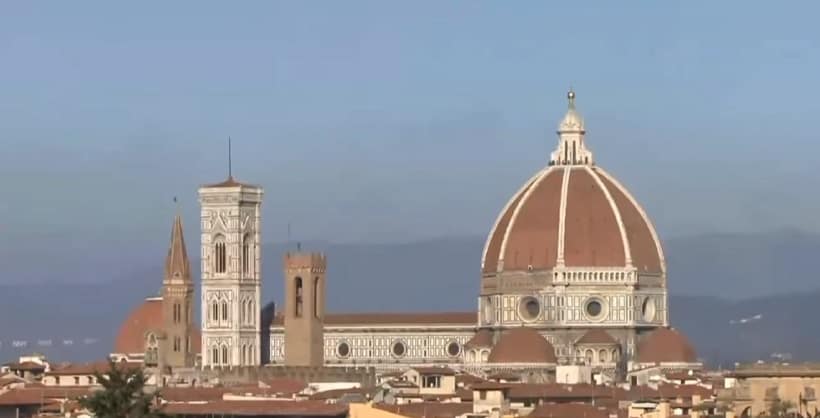
There are so may things to do that encompass Florence sightseeing. Florence is the home of the Renaissance and the capital of Tuscany. Florence is to this day Italy’s center for art and culture. Florence is where Botticelli, Brunelleschi, Donatello, Ghiberti, Giotto, Leonardo da Vinci, Michelangelo all left their mark on the city’s art and architecture, and changed art history forever. Dante and Petrarch changed literature forever. Florence sightseeing includes checking out the old masters that made the Renaissance. And Florence sightseeing includes checking out the modern. Contemporary fashion designers, fine artists, jewelry artisans all make today’s Florence on the cutting edge of art, culture and design.
After you have your Florence hotel you’ll be ready to explore the city that continues to inspire art, fashion, architecture, and cuisine. Florence is a shopper’s paradise in fine leathers, jewelry, clothing, and art, attracting business and leisure travelers from across the globe. Foodies of course dream of the culinary tradition. Below we have listed Florence’s sightseeing highlights and provided a Florence walking map to help you find your way while touring Florence independently. Click Florence day tours for excursions and guided tours of the museums and sightseeing highlights. In between these main Florence sightseeing highlights there are plenty of little streets to explore, shops to browse, and wandering to be done. Buon viaggio.
Florence Sightseeing Highlights
A – Piazza di Santa Maria Novella
The church of Santa Maria Novella was built by the Dominicans between 1279 and 1357. The lower Romanesque part of its facade was incorporated into one based on Classical proportions by the pioneering Renaissance architect Leon Batista Alberti in 1456 to 1470 CE. The Gothic interior contains superb frescoes, including Mosaccio’s powerful Trinity. The famous Green Cloister, frescoed with perspective scenes by Paolo Uccello, and the dramatically decorated Spanish Chapel, now form a museum.
B – Medici Chapel
The Medici Chapels (Cappelle medicee) are two structures at the Basilica of San Lorenzo, Florence, Italy, dating from the 16th and 17th centuries, and built as extensions to Brunelleschi’s 15th-century church, with the purpose of celebrating the Medici family, patrons of the church and Grand Dukes of Tuscany. The Sagrestia Nuova, (“New Sacristy”), was designed by Michelangelo. The larger Cappella dei Principi, (“Chapel of the Princes”), though proposed in the 16th century, was not begun until the early 17th century, its design being a collaboration between the family and architects.
C – Piazza San Lorenzo
San Lorenzo was the parish church of the Medici family. In 1419, Brunelleschi was commissioned to rebuild it in the Renaissance style. Almost a century later, Michelangelo submitted some plans for the facade and began work on the Medici tombs in the Sagrestia nuova. He also designed a library, the Biblioteca Mediceo-Laurenziana, to house the family’s collection of manuscripts. The lavish family mausoleum, the Cappella dei Principi, was started in 1604.
D – Piazza Del Duomo
While much of Florence was rebuilt during the Renaissance, the eastern part of the city retains a distinctly medieval feel. With its maze of tiny alleys, it is an area that would still be familiar to Dante (1261 to 1321), whose birthplace allegedly lay somewhere among these lanes.
The richly-decorated cathedral, known alternately as the ‘Duomo of Florence’ and the ‘The Basilica di Santa Maria del Fiore,’ along with its orange tiled dome, has become Florence’s most famous symbol. Typical of the Florentine determination to lead in all things, the Duomo is Europe’s fourth-largest church and the tallest building in Florence.
E – Accademia dell’Arte del Disegno
The Academy of the Art of Design, founded in 1563, was the first school established in Europe specifically to teach techniques of drawing, painting, and sculpture. The art collection displayed here was formed in 1784 to provide material for students to study and copy. The most famous work is Michelangelo’s David (1504) a colossal (5.2-meter/17-foot) nude of the biblical hero who killed the giant Goliath.
F – Piazza della Signoria / Palazzo della Signoria / Palazzo Vecchio
Piazza della Signoria has been at the center of Florence’s political and social life for centuries. The Piazza is the square located in front of the Palazzo della Signoria also known as Palazzo vecchio.
The great bell that once used to summon citizens to ‘parlamento’ (public meetings) remains here. The square has long been a popular promenade for both visitors and Florentines.
The piazza’s statues (some are copies) commemorate the city’s major historical events. Its most famous episode is celebrated by a simple pavement plaque near the loggia: the execution of the religious leader Girolamo Savonarola who was burnt at the stake.
Palazzo della Signoria / Palazzo Vecchio
Originally called the Palazzo della Signoria, after the Signoria of Florence, the ruling body of the Republic of Florence, this building was also known by several other names: Palazzo del Popolo, Palazzo dei Priori, and Palazzo Ducale, in accordance with the varying use of the palace during its long history. Today it is also known as the Palazzo Vecchio.
it is the most important historic government building in Florence. It was the seat of the Signoria of the Florentine Republic in the 14th century and then the government center of the Medici grand dukes of Tuscany. From 1865 to 1871 it housed the Chamber of Deputies of the Kingdom of Italy. Then, since 1872 it has been Florence’s town hall.
G – La Basilica di Santa Croce
The Basilica di Santa Croce (Basilica of the Holy Cross) is the principal Franciscan church in Florence, Italy, and a minor basilica of the Roman Catholic Church. It is situated on the Piazza di Santa Croce, about 800 meters south west of the Duomo. The site, when first chosen, was in marshland outside the city walls. It is the burial place of some of the most illustrious Italians, such as Michelangelo, Galileo, Machiavelli, Foscolo, Gentile and Rossini, thus it is known also as the Temple of the Italian Glories (Tempio dell’Itale Glorie).
H – Palazzo Antinori
Palazzo Antinori was built in 1461 to 1466 and is one of the finest small Renaissance palazzi in Florence. It was acquired by the Antinori in 1506 and has remained with the family every since. The dynasty owns many estates all over Tuscany and Umbria, producing a range of wines, oils, and liqueurs. The Cantinetta Antinori, a wine bar off the main courtyard, offers samples of these gastronomical delights.
I – Piazzale Michelangelo
Of all the great Florentine views, such as the Duomo and Campanile, none offers such a magnificent panorama of the city as Piazzale Michelangelo. Designed in the 1860s by Giuseppe Poggi and dotted with copies of Michelangelo’s statues, its balconies attract many visitors and the inevitable masses of souvenir peddlers. However, this square remains an evoticative spot, especially when the sun sets over the Arno river and distant Tuscan hills.
J – Palazzo Pitti
The Palazzo Pitti was originally built for the banker Luca Pitti. The huge scale of the building, begun in 1457 and attributed to Brunelleschi, illustrated Pitti’s determination to outrival the Medici family through its display of wealth and power. Ironically, the Medici later purchased the Palazzo when building costs bankrupted Pitti’s heirs. In 1550, it became the main residence of the Medici and all the subsequent rulers of the city. Today, the richly decorated rooms exhibit countless treasures from the Medici collections.
K – Ponte Vecchio & Palazzo Vecchio
The Ponte Vecchio (“Old Bridge”) is a Medieval stone closed-spandrel segmental arch bridge over the Arno River, in Florence, Italy, noted for still having shops built along it, as was once common. Butchers initially occupied the shops; the present tenants are jewelers, art dealers and souvenir sellers. The Ponte Vecchio’s two neighboring bridges are the Ponte Santa Trinita and the Ponte alle Grazie. This bridge connects the Oltrano neighborhood around the Piazza Pitti with the center.
L – Uffizi Art Gallery
The Uffizi, Italy’s greatest art gallery, was built between 1560 to 1580 CE to house offices for Duke Cosimo I. The architect Vasari used iron as reinforcement, enabling his successor, Buontalenti, to create an almost continuous wall of glass on the upper floor. This was used as a gallery for Francesco I to display the Medici art treasures. The collection was divided up in the 19th century. Ancient objects went to the archeological museum and sculpture to the Bargello, leaving the Uffizi with a matchless collection of paintings.
M – Via Tornabuoni
Via de’ Tornabuoni, or Via Tornabuoni, is a street of the center of Florence, Italy, that goes from Antinori square to ponte Santa Trinità, across Santa Trinità square, characterized by the presence of fashion boutiques. The street houses high fashion boutiques, belonging to stylists such as Gucci, Salvatore Ferragamo, Enrico Coveri, Roberto Cavalli, Emilio Pucci and others.
N – Mercato Centrale
In the middle of the San Lorenzo street market is the bustling Mercato Centrale, Florence’s busiest food market. It is housed in a vast two-story building of cast-iron and glass, built in 1874 by Giuseppe Mengoni. The ground floor stalls sell meat, poultry, fish, salami, ham, cheeses, and a myriad of olive oils. There are also Tuscan foods such as porchetta (roast suckling pig), lampredotto (pig’s intestines), and trippa (tripe). Fresh fruits, vegetables and flowers are sold on the top floor. Look for wild mushrooms and truffles in the autumn and broad beans, peas, and baby artichokes in early spring.
Palazzo Strozzi
Cattedrale de Santa Maria del Fiore
Bargello National Museum
For more information about touring Italy check out our check out our Italy travel guide.



